Wondering how to structure and streamline the recruitment process in your organization with Microsoft Teams? Keep reading! In this blog post we will cover all the Collaboration template capabilities that can boost productivity of your recruitment team and explain how to create a Recruitment template in Microsoft Teams.
Why do you need a Recruitment template?
Structured hiring process
If you work in a large organization and frequently hire new employees, you may want to have a structured hiring process that will allow your HR teams to fill new positions faster and more efficiently. That’s what a Recruitment template will help you achieve. All the Recruitment teams will be organized in a similar way, contain the same channels, files, folders, and tabs with everyday apps.
Faster and more coordinated recruiting
With all the necessary tools ready at place your hiring team can get to work straight away. No longer will they lose time on searching for the right data and organizing their workspace. Already configured channels will help your recruiters have focused discussions and pre-built set of tasks will let them coordinate their activities much faster.
Better employee experience
Having an organized and structured team for collaboration on specific projects increases team productivity and efficiency. Your recruitment team can focus entirely on the recruitment process without distracting themselves on organizing their workspace.
Automated manual tasks
With SalesTim connector in Power Automate you can automate many routine processes in Microsoft Teams such as setting up notifications, creating teams, channels, tabs, etc., saving your employees their time and nerve.
Advanced Microsoft Teams templates capabilities for a Recruitment Template
What will you get?
Microsoft Teams templates answer the needs of both your end-users and IT department thanks to advanced governance policies. First, let’s have a look at the key template capabilities that improve the way your employees work and collaborate in Teams.
Structured teams with channels
Define the stages of the recruitment process in your organization and create corresponding channels in your original Recruitment team on which you will base your template. To differentiate the teams on which you’ll base your templates and regular teams, name your original team Recruitment – Template.
Having a dedicated channel for each stage of recruiting will allow your hiring team to have focused discussions, navigate easily through team’s content and refer faster to the right data.
Here are our channel name suggestions:
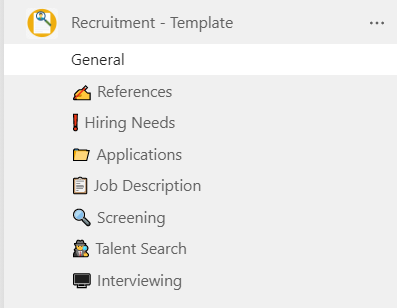
- Hiring Needs
- Job Description
- Talent Search
- Applications
- References
- Screening
- Interviewing
Copied files and folders
To make sure all your Recruitment teams have required documentation ready at place, you can upload all the necessary files and folders in Files tab in respective channels of your original team. That can be Equal opportunity and diversity policies and guidelines, recruitment policies, job description templates, job application forms, interview guidance notes, etc.
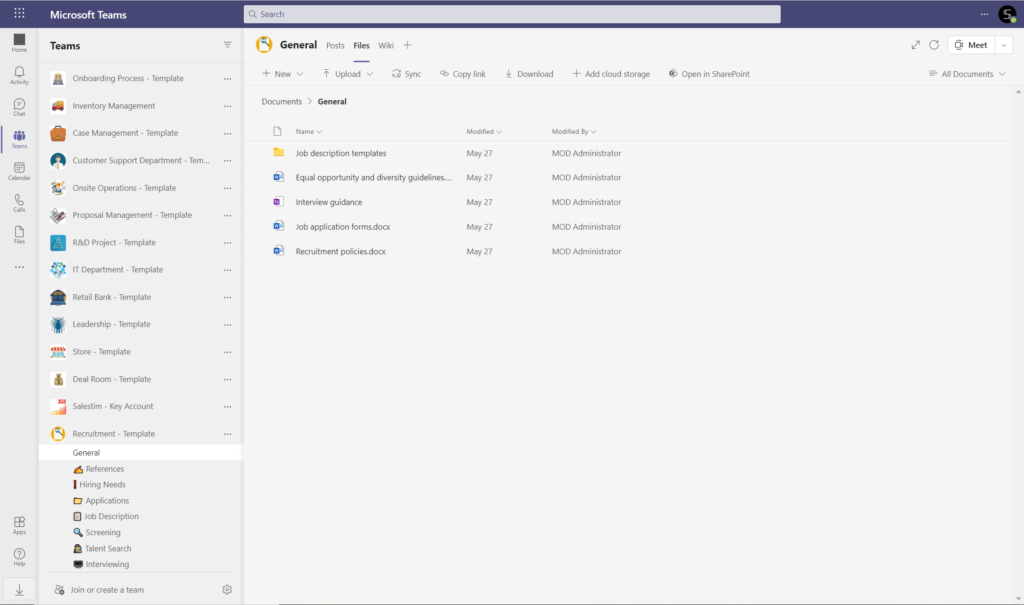
When new teams are created from your template, all the files and folders will be automatically cloned. This way, your teams will save their time on searching for the right information.
You may want to pin key documents as tabs in corresponding channels for easier access and better visibility.
Tasks for filling a new position
You can add Planner tab in relevant channels prepare a standard set of tasks that your recruitment team could use to start filling out a new position straight away.
If you have a strategy for talent search, you can formulate it with tasks and assign them to the right people. Additionally, you can add checklists, attach files and links, set priority levels and labels.
Each team created from this template will automatically copy all the tasks pre-built in Planner. This way, your teams will immediately now what to do and collaborate more efficiently on filling in the position.
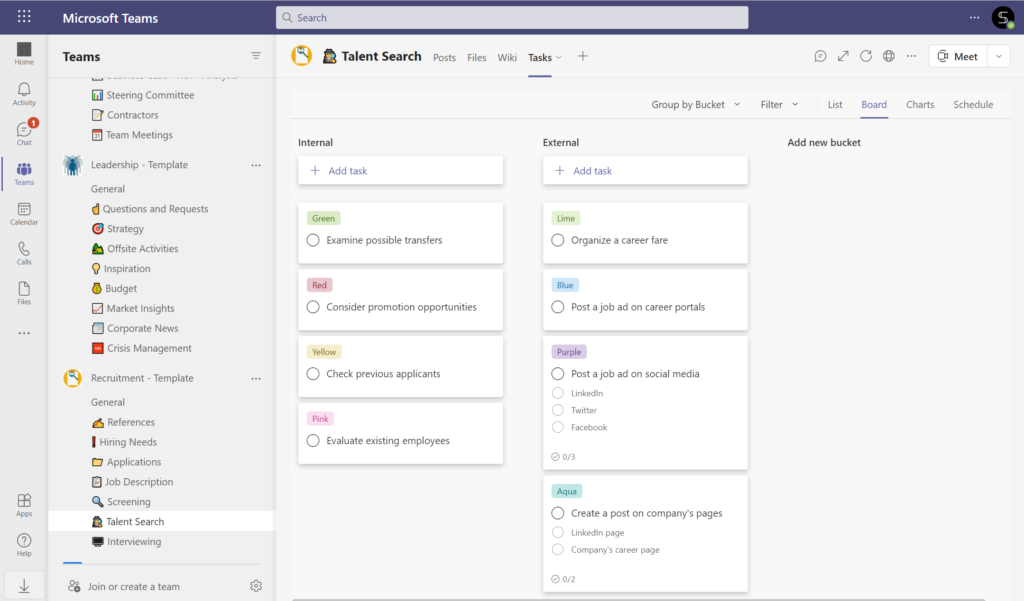
Get team feedback with Forms
To share feedback regarding performance of each candidate during the interview process you can create a form in Microsoft Forms asking to evaluate a candidate and then pin this form as a tab in Screening channel. This way, your hiring team can screen all their candidates much faster.
Organize productive meetings with Calendar tab
You can add a Calendar tab in your Interviewing channel and set up all your interviews through it. This way, all your hiring team can plan their daily and weekly schedule and choose the time slots for interviews that will suit every member involved in the interviewing process.
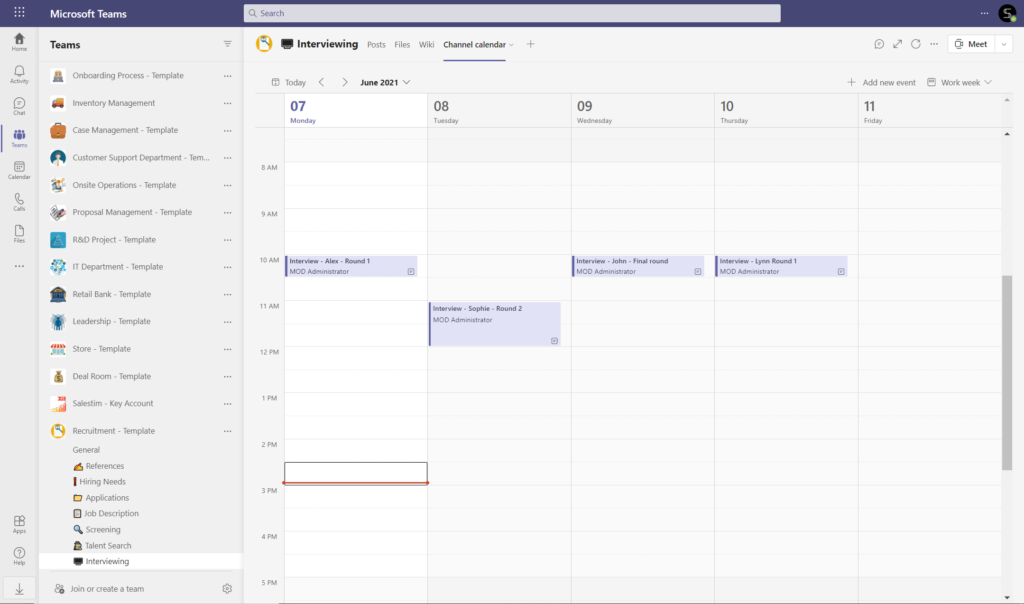
Get the right people immediately involved
With Microsoft Teams Collaboration templates, you can add default Permanent owners and members to your future teams. This way, whenever a new Recruitment team is created from the template, the right people will automatically get involved.
You may also consider adding your hiring manager as a Permanent owner and your hiring team as Permanent members of Recruitment teams.
Communicate with fellow colleagues through Yammer
If your organization has multiple branches across the world, you can create HR community in Yammer and encourage communication with your HR experts across the entire organization. Your HR teams can consult their colleagues from a different country, share their expertise and best practices, as well as support employee transfers.
Integrations with HR apps
If your HR professional use third-party tools such as Workday to manage employees and fill new positions, you can integrate them into your Teams environment and collaborate in a more efficient way. For example, for the recruitment process you can quickly gather interview feedback on a job candidate and make your next hire.

What will you get from IT perspective?
Microsoft Teams Collaboration templates also address a number of IT needs through advanced governance policies. Let’s point out some of them:
Naming convention
To make sure your HR teams can easily navigate through all their teams, it’s worth considering implementing naming rules for your teams. This way, they can easily refer to a needed team and keep their focus on current projects. Additionally, it helps your IT department better manage all the teams in the tenant.
With Microsoft Teams Collaboration templates, you can add both fixed and dynamic attributes from Azure AD to the Naming convention, such as user location, department, country, etc.
For example, you may choose to set up the following naming convention for your Recruitment template.
Recruitment – Job title (team name) – Department
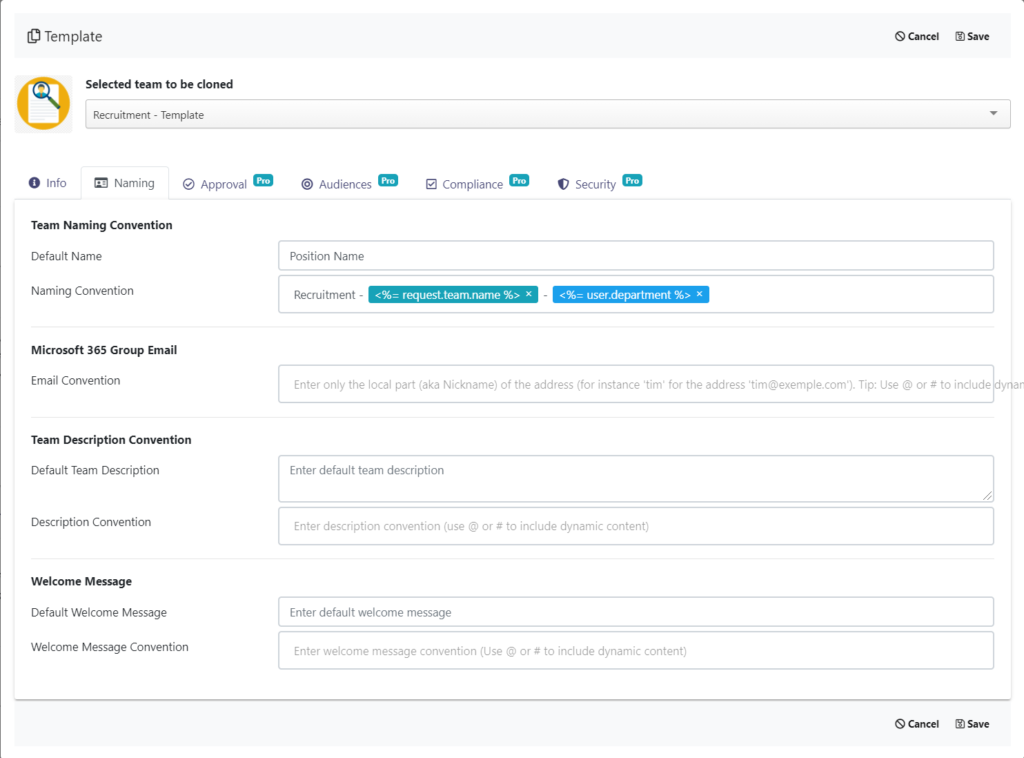
Audience targeting
To make sure only the right people in your organization can create teams from a particular template, you can configure Audience targeting. For your Recruitment template, for example, you may choose to make it accessible only to your HR department. This way, you prevent creation of unnecessary teams, therefore avoiding Teams sprawl.
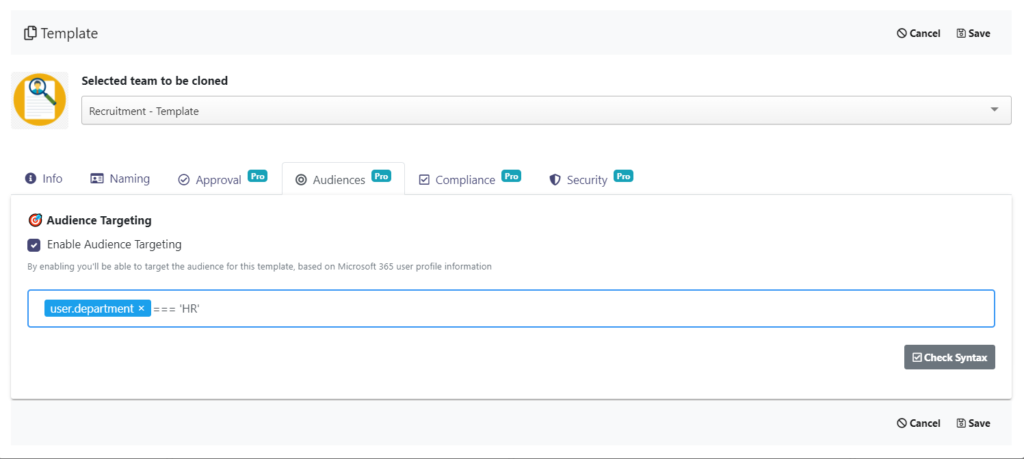
Approval workflow
Additionally, you can assign approvers at the template level to make sure the team creation process is run by them. For instance, you can add the HR manager as an approver and whenever someone sends a request for creating a new team, they will receive a notification and decide whether to approve or reject it.
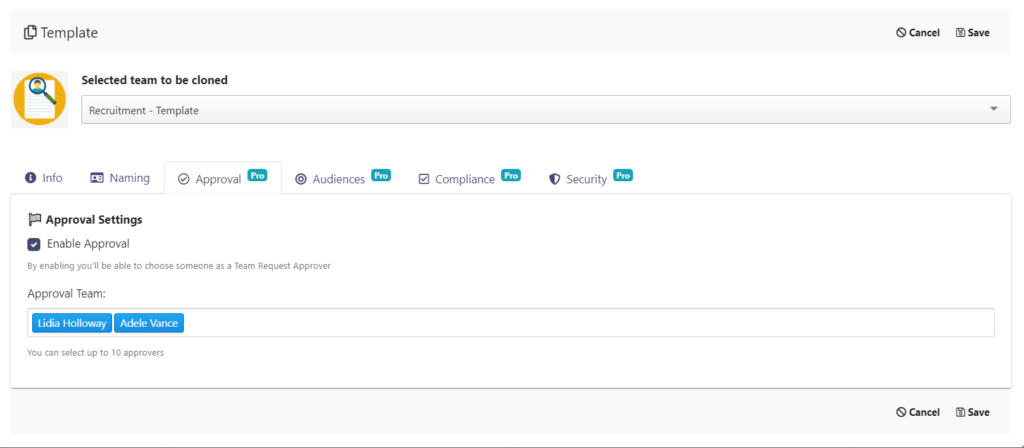
Membership policies
Add Permanent members and owners at the template level to make sure your hiring team will be automatically added to Recruitment teams.
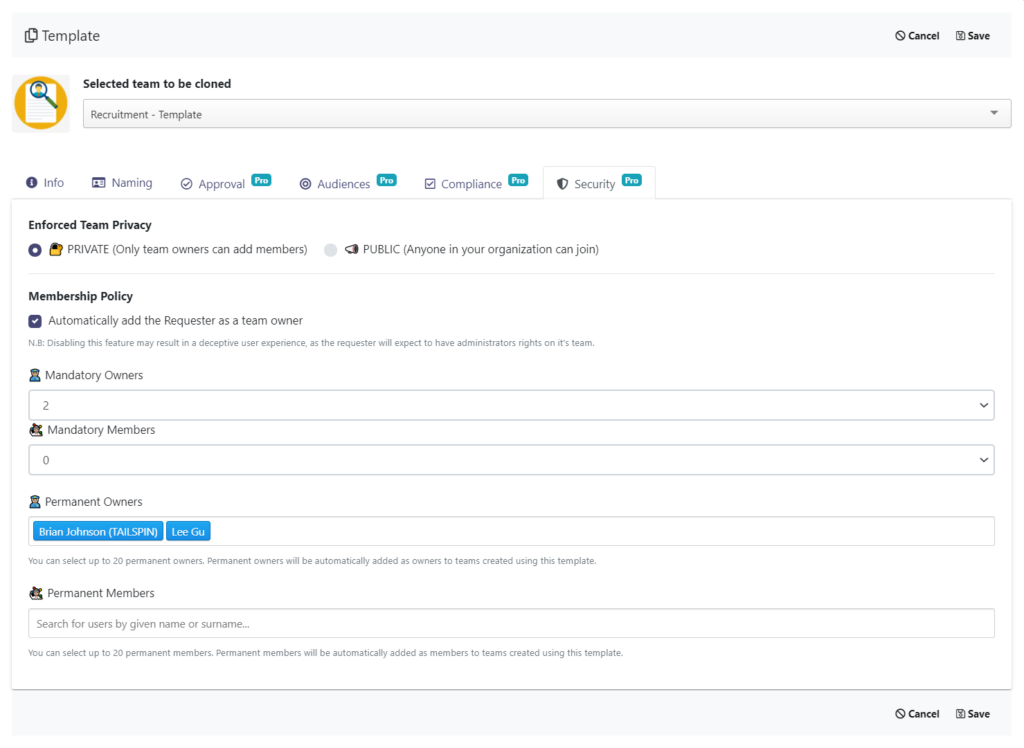
Automation with Power Automate
With SalesTim automation and Power Automate you can automate manual processes and increase your HR team efficiency. By using Microsoft Teams connector, you can manage notifications, team/channel/tab creation, set up approval processes, etc.
For the recruitment use case, you can create a form in Microsoft Forms that should be filled by managers whenever they request a new hire. The form may contain such fields as job title, name of the department, key responsibilities, and job requirements. Use the form submission as a trigger in Power Automate to create a new recruitment team from your Recruitment template.
At the same time, you can create a list in Microsoft Lists to keep truck of all the new job openings, use the fields in the form to send data to this list through Power Automate.
Explore more Power Automate use cases in this blog post.
How to build a Recruitment template in Microsoft Teams?
Now let’s go through the steps of the template creation
1. Install SalesTim app from Microsoft Teams store. Note that only admin users can manage the app.
2. As a Global Admin or Template Catalog Manager, head over to SalesTim tab on the left bar of Teams, click on Catalog > +New template. Now you will need to select the original team that should be cloned – Recruitment – Template.
3. Configure governance policies that you’d like to implement for your teams. You can set up naming rules, define who can use your template, add permanent owners and members, and other. Then, click Save.
4. Your template is ready! Now it is added to your Template catalog. Your end-user can use it to create new Recruitment teams. Note that if you configured Audience targeting, only selected users will be able to access the template.

Each new team will contain all the content that you’ve added to your template will be automatically cloned. That includes standard and private channels, tabs with apps, pre-build Planner, files, and folders.
Book a demo to learn how to build your own Microsoft Teams template tailored for your organizational needs.
